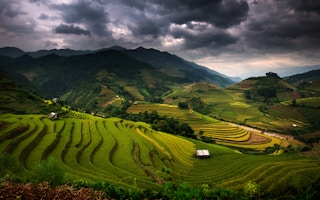Clouds hung heavy over the rice fields at the International Rice Research Institute (IRRI) in Laguna last April 15, seemingly auguring dark times ahead for the world’s longest-running rice experiment, which turned 52 on that day.
“Mukhang uulan,” said Tony Lambino, IRRI’s Head of Communications, just as the celebrations for the Long-Term Continuous Cropping Experiment’s (LTCCE’s) anniversary were about to begin.
World’s longest-running rice experiment
Since 1962, the LTCCE has been working to determine the impact of continuously growing irrigated rice on overall crop productivity and soil health.
This year marks the 150th harvest taken from the same soil from the same field in all those 52 years: each year, the field is harvested three times instead of the usual two. In a typical year, this amounts to 17 tonnes of rice per hectare.
“
The main effect that we’re facing is the regular weather that a farmer is going to face, and that’s temperature, sunshine, etc. What’s happening in much of the world is that temperatures are changing. Sunshine is changing
Dr. Roland Burech, scientist managing the Long-Term Continuous Cropping Experiment, IRRI
So far, the experiment has proven that the judicious use of fertiliser, disease- and insect-resistant rice varieties, soil flooding, and the application of good management practices can result in an abundant annual yield.
But climate change threatens to change all that.
Declining yields
The potential maximum yield that rice varieties can achieve under certain climatic conditions has been declining over the years due climate cycles that produce more days like the cloudy, sunlight-deprived morning on the day of the anniversary.
“If we take the weather data that comes from (IRRI’s) Meteorological Station, plug that into crop simulation models, and estimate the potential yield that’s driven by the germplasm and the climate, what we find is that the potential yield over the last 10 to 15 years has been declining,” Dr. Roland Burech, one of the scientists managing LTCCE, explained.
From 1992 to 2012, the potential yield in the dry season each year (January - April) has been going down. In 1993, the highest annual potential yield in 10 years was recorded at a little over 11 t/ha (tonnes per hectare). That number erratically went up and down until 1997, and sloped to 9.25 hectares in 2001. By 2012, the potential yield had dropped to 8 t/ha.nes
The culprit: Climate change
“This is because in the national cycles that are taking place in the climate, (we) see a tendency for more La Nina than El Nino events: more cloudiness, more (of the) weather that you’re seeing today, less solar radiation, and less sunshine. (This means) less yield.”
The LTCCE may be producing more rice in terms of tons per hectare compared to a regular farmer’s land, but the maximum potential yield it can produce has been dropping as well.
“The main effect that we’re facing is the regular weather that a farmer is going to face, and that’s temperature, sunshine, etc. What’s happening in much of the world is that temperatures are changing. Sunshine is changing,” Burech said in a separate interview with the press.
A silver lining
This, however, may not necessarily be entirely a bad thing.
“We in the Philippines have gone through a cycle heavily orientated towards La Nina, which means more cloudy conditions, more rainfall. Under more cloudy and rainy conditions, the yields are lower, but more farmers can plant rice because there’s more rainfall. So it’s sort of a mixed blessing. The yields might be a little lower, but the overall production doesn’t hurt in the country because more farmers can produce,” Burech said.
The challenge now is to see how to sustain this intensive, high-yielding system in the face of a changing climate.
“What we have here now is a tremendous opportunity in this experiment, where we have records through time, and the opportunities to really see how to sustain this system in a changing climate. So we have now before us, is not only the 50 years of history of sustainability, but the opportunity for this to be a benchmark on sustainability in the future with a changing climate,” Burech said.










